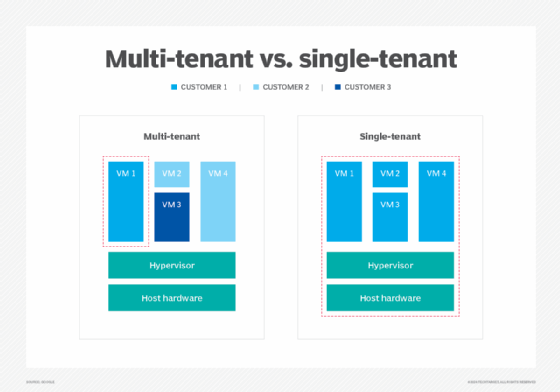What is single-tenancy? How's it different from multi-tenancy?
Single-tenancy is an architecture in which a single instance of a software application and supporting infrastructure serves one customer. Single-tenancy is commonly implemented in software as a service (SaaS) delivery models or in cloud services.
In single-tenancy architectures, a customer -- called a tenant -- has a singular instance of a SaaS application dedicated to them. The host provider will aid in managing the software instance and dedicated infrastructure while still lending nearly full control to a single tenant to customize their software and infrastructure.
Some common characteristics of single-tenancy models are that they tend to provide a high level of user engagement and user control, as well as reliability, security and backup ability. Because tenants are in a separate environment from one another, they are not bound in the same way tenants using a shared infrastructure would be.
Potential customers would likely choose a single-tenant infrastructure over other possible options for the ability to have more control and flexibility in their environment.
How single-tenancy works
In a single-tenancy architecture, every tenant has their own single database and software instance, which isolates each tenant's data from one another. In addition, the architecture only allows one instance per SaaS server. Each piece of software might be purpose-built for the new tenant, or the tenant can customize the user interface (UI) after installation. Once the software is installed locally, tenants can typically customize the software to best suit what is needed for their specific environment, but they do not have access to any underlying code.
Each tenant's data should also have an isolated backup, so if there is any data loss, tenants should have an easy time restoring their data. In addition, tenants can typically choose when to install any available updates individually instead of waiting for the service provider to do so.
Cloud adoption of single-tenancy architectures in cloud computing is common as well. In most cases, if someone uses a private cloud service or a third-party cloud offering, it is most likely a single-tenant system. This is because an individual would be the only customer with access to that instance, with security and management options as well as individual controls.

Benefits and drawbacks of single-tenancy
Single-tenancy has some noticeable benefits that keep it open as an option when deciding on a service architecture. Some benefits include the following:
- Portability. Single-tenant instances through a cloud service or SaaS. Single-tenancy might also lend itself to migrating from a host environment, if needed.
- Data security. Even if there is a data breach to one tenant with the same service provider, another tenant would be safe from the breach since data is stored in a separate instance.
- Data customization. Because all a customer's data is separate, a large degree of customization is possible for software and hardware instances.
- Reliability. Single-tenant instances are considered reliable because performance is based on only one instance instead of many from different tenants.
- Restore and disaster recovery. Isolated backups allow users to quickly enable a recovery if there is a disaster and data is lost.
With all the potential advantages to single-tenancy, it is still the lesser-used option out of competing architectures, which could be due to some of its disadvantages. Drawbacks to single-tenancy include the following:
- High costs. Between setup time, resources, customization, and maintenance, hosting one SaaS instance per customer can come at a price.
- Complex set-up. Because the tenant normally manages a single-tenant system, it takes more time to update, upgrade or manage something.
- Complex management. Learning curves can appear when first beginning to implement and customize a single-tenancy SaaS.
- Underutilized resources. In a less optimized system, not all resources may be utilized, which makes for a less efficient system.
Requirements for single-tenancy
Requirements needed in single-tenant environments include the following:
- Initial startup time. Single-tenancy involves significant startup time because the software has to be built or customized for each tenant.
- Maintenance resources. Single-tenant environments tend to require more maintenance and upkeep, meaning end users should have the resources and time needed for the upkeep.
- Administrative support. Because the underlying code of a single-tenancy SaaS application is blocked off, major extensions and third-party integrations might require administrative support from the host service.
Multi-tenancy vs. single-tenancy
Single-tenancy is typically contrasted with Multi-tenancy, an architecture in which a single instance of a software application serves multiple customers. In a multi-tenant architecture, each customer shares the same database and application. Multi-tenancy is typically ideal for businesses that want an easier startup experience and fewer hardware requirements. The architecture has become an industry standard for enterprise SaaS environments.
In comparison to single-tenancy, multi-tenancy is as follows:
- Cheaper.
- Efficiently uses resources.
- Lowers maintenance costs.
- Has a larger computing capacity.
Even though multi-tenancy has a lot of visible advantages over single-tenancy, the ability to make significant customizable changes to the software is hampered because the software is shared among other tenants. In addition, multi-tenancy can experience more downtime.
When deciding between single- and multi-tenancy, users should consider how much customizability they want or need. However, it is important to note that most SaaS services operate on multi-tenancy.
This article was republished to improve the reader experience.








